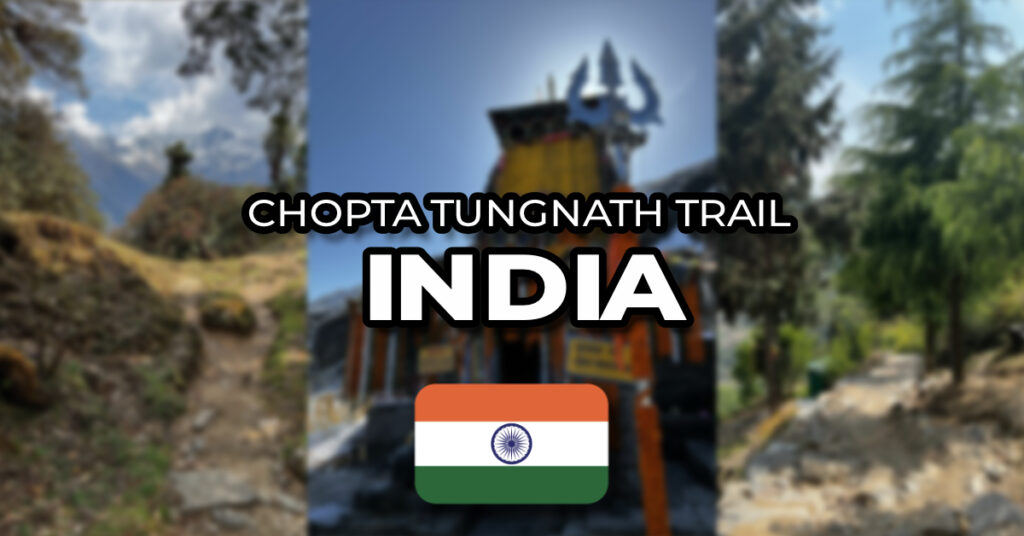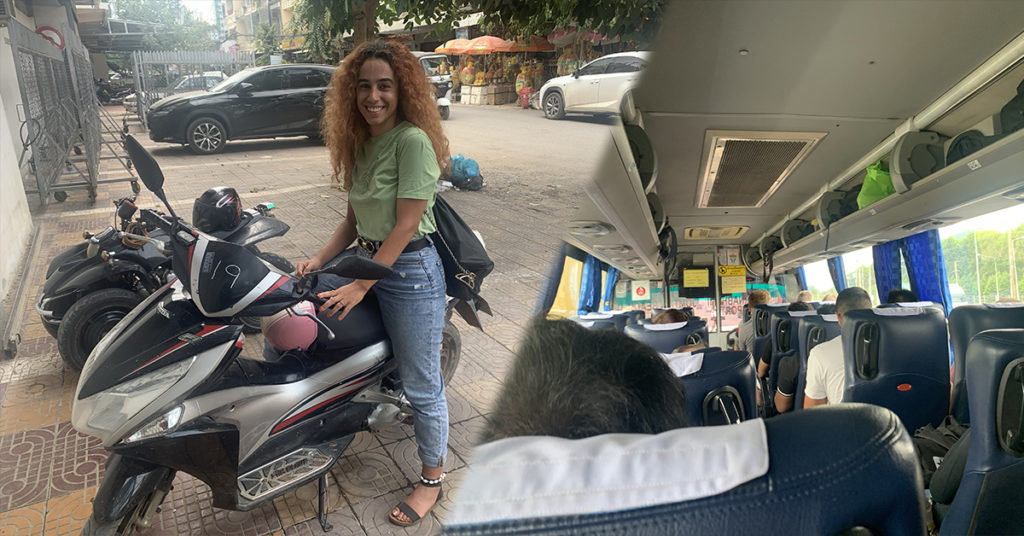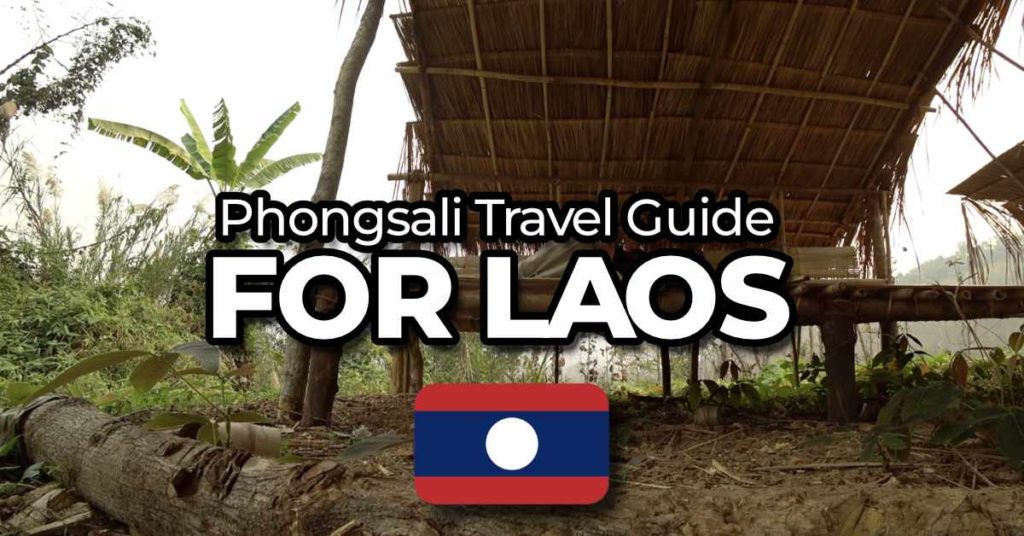The Chopta Tungnath trek in the Garhwali region of the Himalayas is a one-of-a-kind adventure, though unfortunately, you can hardly find accurate information about it online. This is what inspired me to write this guide, having hiked the trail myself. Here, I’d provide you with some handy and reliable tips to navigate this beautiful trail in the lap of the mighty Himalayas, complete with what to do to prepare for it, how to navigate it, how challenging it can be, some fun facts about the trek, and other information that might be useful if you’re planning to head here.
So, lace up your hiking boots and accompany me on this step-by-step guide to the Chopta Tungnath hiking trail, where I’ll guide you step-by-step, from essential tips to hidden gems along the trail. By the end of this article, you’ll not only be equipped with all the practical insights for the trek but also be inspired to embark on this adventure of a lifetime!
How Difficult Is It?
The Tungnath trek, known for its easy-to-moderate difficulty, is perfect for beginners to high-altitude hiking. With well-marked, maintained paths, it’s challenging mainly due to its steep climbs and high altitude. Suitable for anyone who can walk a few hours, but take care on the Sari to Chopta stretch, as it’s tough and long
I personally struggled on the Sari to Chopta section, which can be challenging and covers a considerable distance. If you’re not a frequent trekker or in great physical condition, starting from Chopta might be a more manageable option for you.
Best Time To Visit
It’s incredibly important to pick the optimal time to do the Chopta Tungnath trek. While it’s feasible throughout the year, the weather can pose many challenges during certain months. For unparalleled views of the Himalayan mountain ranges, plan your trek between September and November. If you want views of thousands of blossoming Rhododendrons and other spring-summer flowering trees, the ideal months are March to early May.
Avoid undertaking this trek during the monsoon months of June to August, as the weather can create slippery conditions, making the trail potentially dangerous. For the adventurous souls considering a winter trek, be prepared for added challenges. Chopta accessibility may be hindered by snow-covered roads, with most of the guesthouses and restaurants closed. It’s strongly recommended to opt for a tour operator during winter treks. Navigating the path to Chandrashila and Tungnath becomes particularly challenging due to frozen ice, making crampons and additional equipment necessary for safety and success. Plan your Tungnath and Chandrashila trek wisely.
Trekking Essentials
Prioritize thorough preparation for the trek, as the route, while popular, is quite remote. Ensure that you pack all the necessary essentials for a smooth journey. Learning from my own experience, inadequate preparation led to many hassles that could have been avoided, further reminding me of the importance of being well-equipped. Additionally, be mindful of the temperatures, especially at Tungnath, where it can get quite cold even in the day. Equip yourself with the right gear and essentials to make the most of your trekking adventure, all the while staying comfortable and prepared for varying conditions.
Don’t forget to bring:
- Two to three warm sweaters
- Ear warmers/woolen headband
- One warm jacket
- One warm pants
- Three warm thick socks
- One pair of very sturdy shoes (made that mistake once, thank me later)
- One or two good quality power banks (there is no electricity throughout the route)
- Wet wipes – often there’s no availability of hot showers
- Sufficient amount of cash – there are no ATM’s nearby, and you’d need it
- Head torch
- Snacks and water to last you the route
- Gloves
If you’re planning to climb up to Chandrashila, you should consider bringing clamp-ons, micro spikes and gaiters. This is in case that there is snow or ice on the trail. If you’re unexperienced with such situations and don’t have an experienced guide with you, I strongly advise against going here.
Do I Need A Guide?
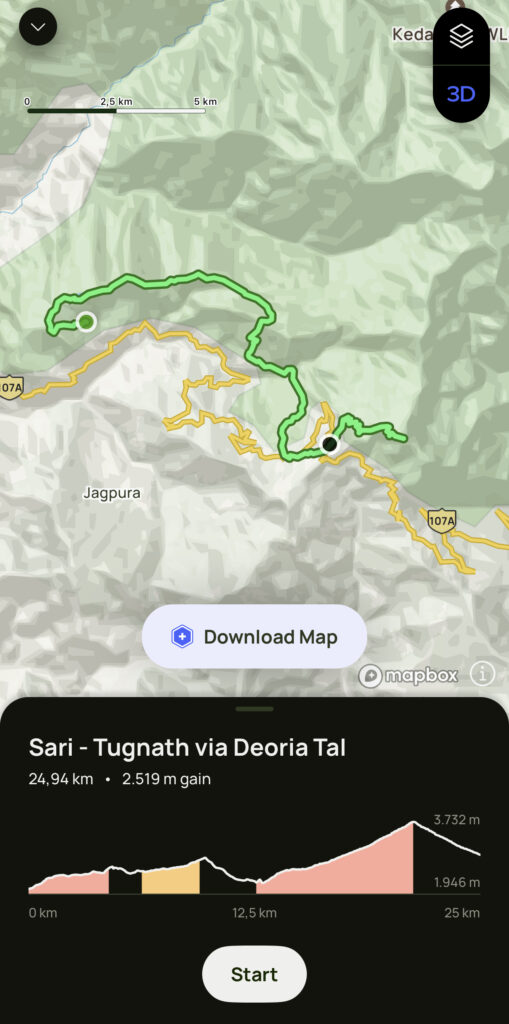
Navigating the trek from Chopta to Tungnath is a solo-friendly venture. The well-marked path ensures a straightforward journey, minus any significant challenges or dangers. However, if your destination is Chandrashila and you lack experience with ice and snow trekking, or if you’re without the necessary equipment, it’s advisable to opt for an experienced guide. While some sections may be clear for independent trekking, the icy conditions demand some caution.
For those commencing their trek from Deoriatal, hiring a guide is highly recommended. The trail lacks clear markings, with a real risk of getting lost without proper guidance. If you’re familiar with using routes online, you can do it without one as well, though I personally would advise getting a guide for safety and security reasons.
During my personal trek, I successfully navigated without a guide, accompanied by fellow travelers I met on the way. We relied on AllTrails for directions, which worked out pretty well by the end of it. Keep in mind that mobile service may be unavailable for most of the trek, so make sure to download offline maps before heading here. Utilize the seven-day free trial of the AllTrails app for offline navigation – here is the map link.
Remember to follow the route until Chopta, where an overnight stay is recommended. Choose wisely between solo exploration and guided assistance to make sure that your Tungnath and Chandrashila hike is comfortable and safe.
Where To Stay in Sari & Food Options
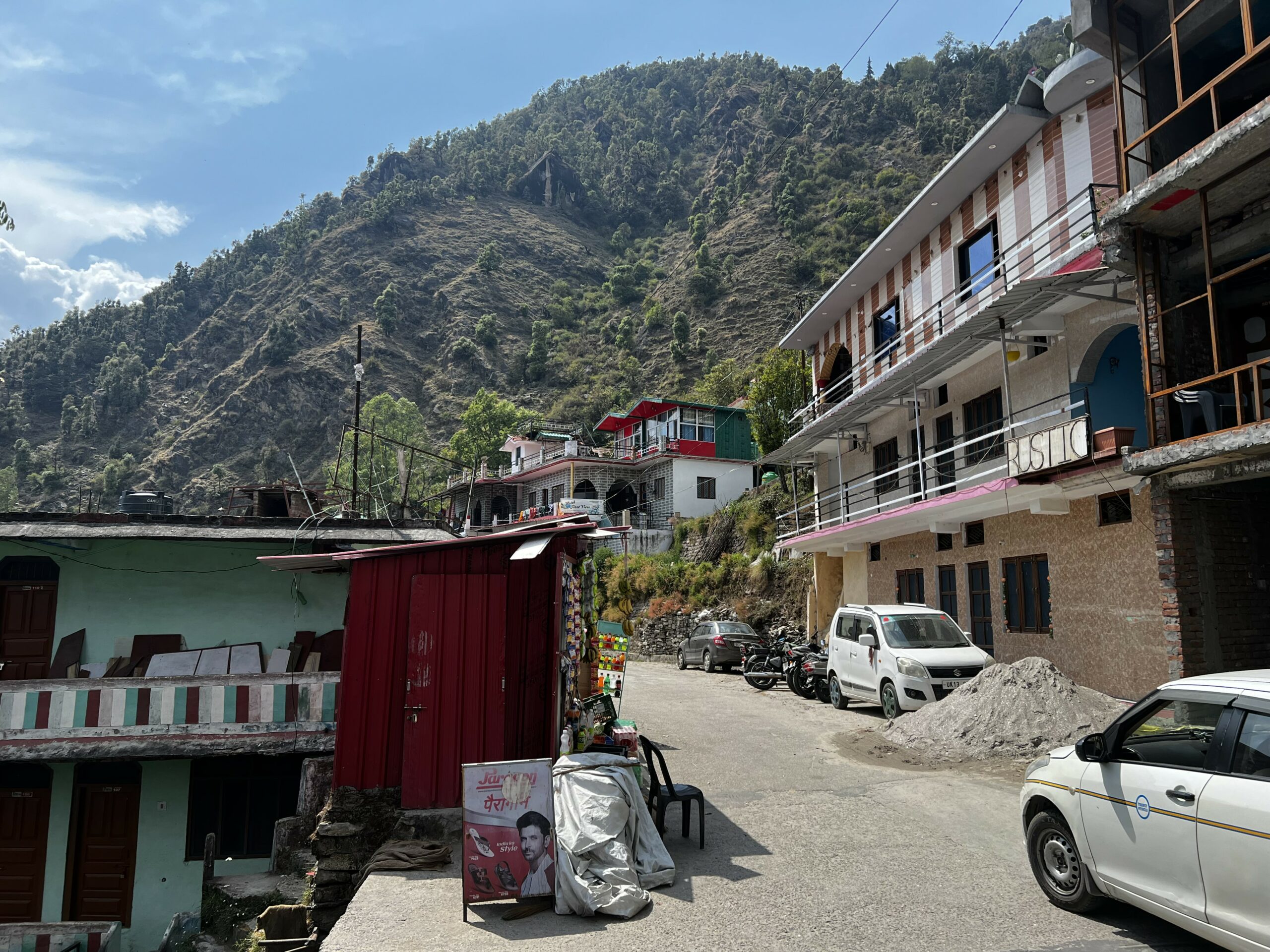
Sari Village
In Sari Village, accommodation options include homestays, guesthouses, and a limited number of budget hotels. Given the remote and less touristy nature of this settlement, expect basic facilities. For a convenient starting point, consider trekking to Deoriatal and spending the night in one of the guesthouses along the trail. Since these places cannot be booked online, the traditional method of in-person inquiry is recommended. Along the trail, there are four stalls, some of which offer accommodation.
During my trek, our group of four stayed at one such stall, with basic rooms without amenities like showers or heaters. The cost was about INR 350 per person with some room for negotiation—a common practice in these areas. Prices may vary based on the time of your visit.
While Sari Village has a few restaurants, options are limited, though I still recommend having lunch here. Additionally, purchase snacks and water here, as prices double once you hit the trail. The lack of a road leading to the shops means that all products are transported by porters or donkeys, impacting prices.
Sari to Deoriatal Trek
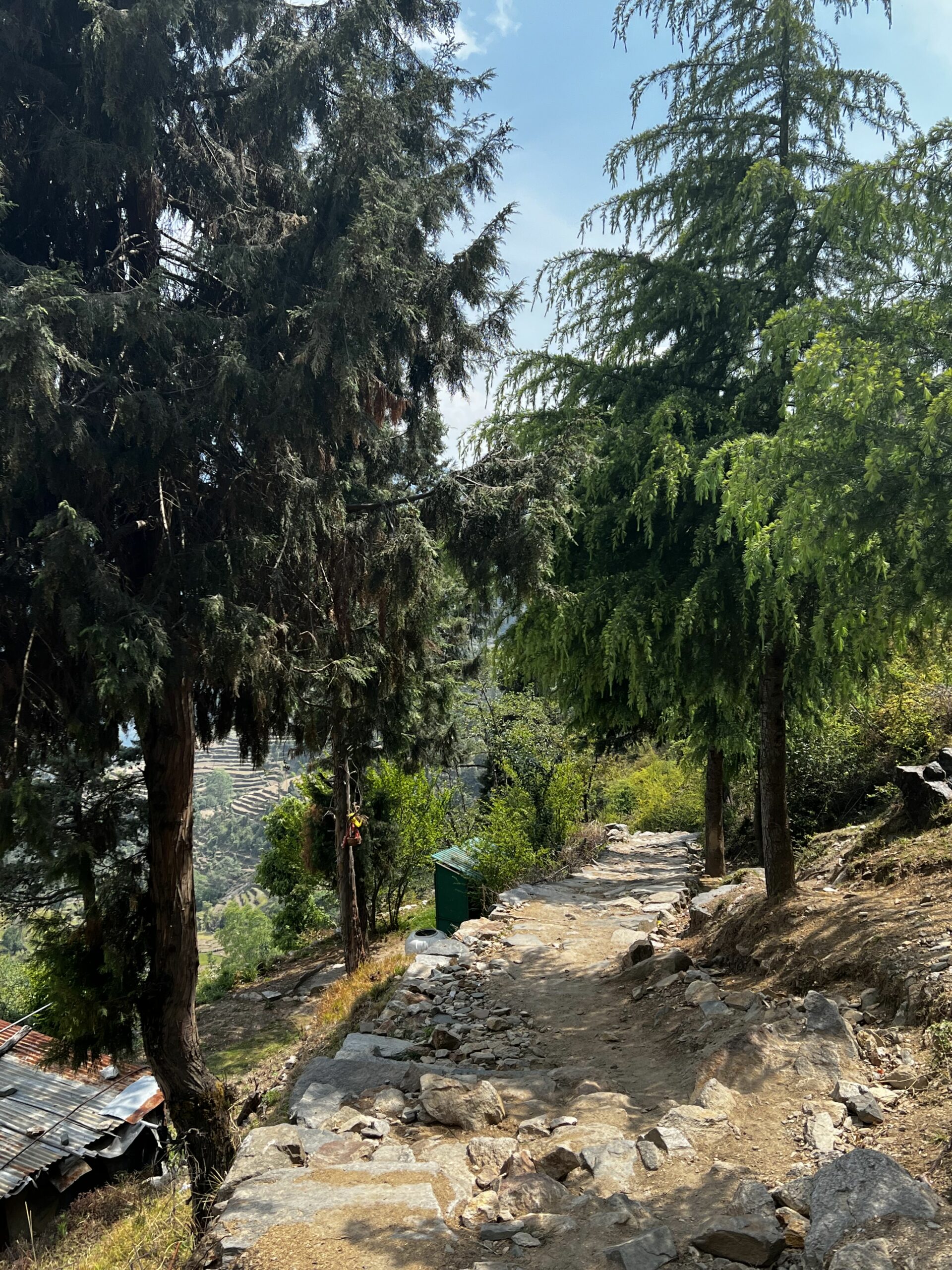
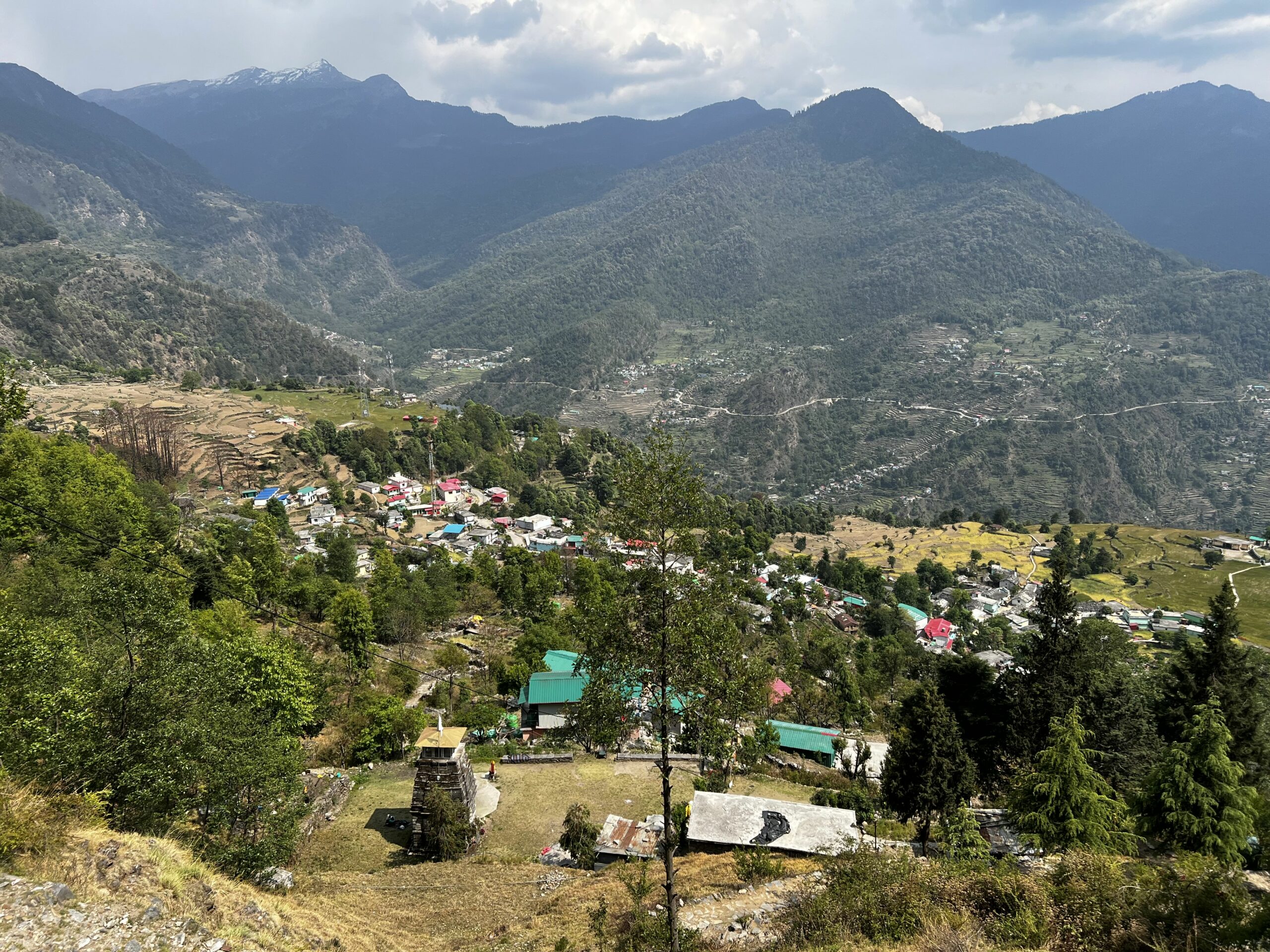
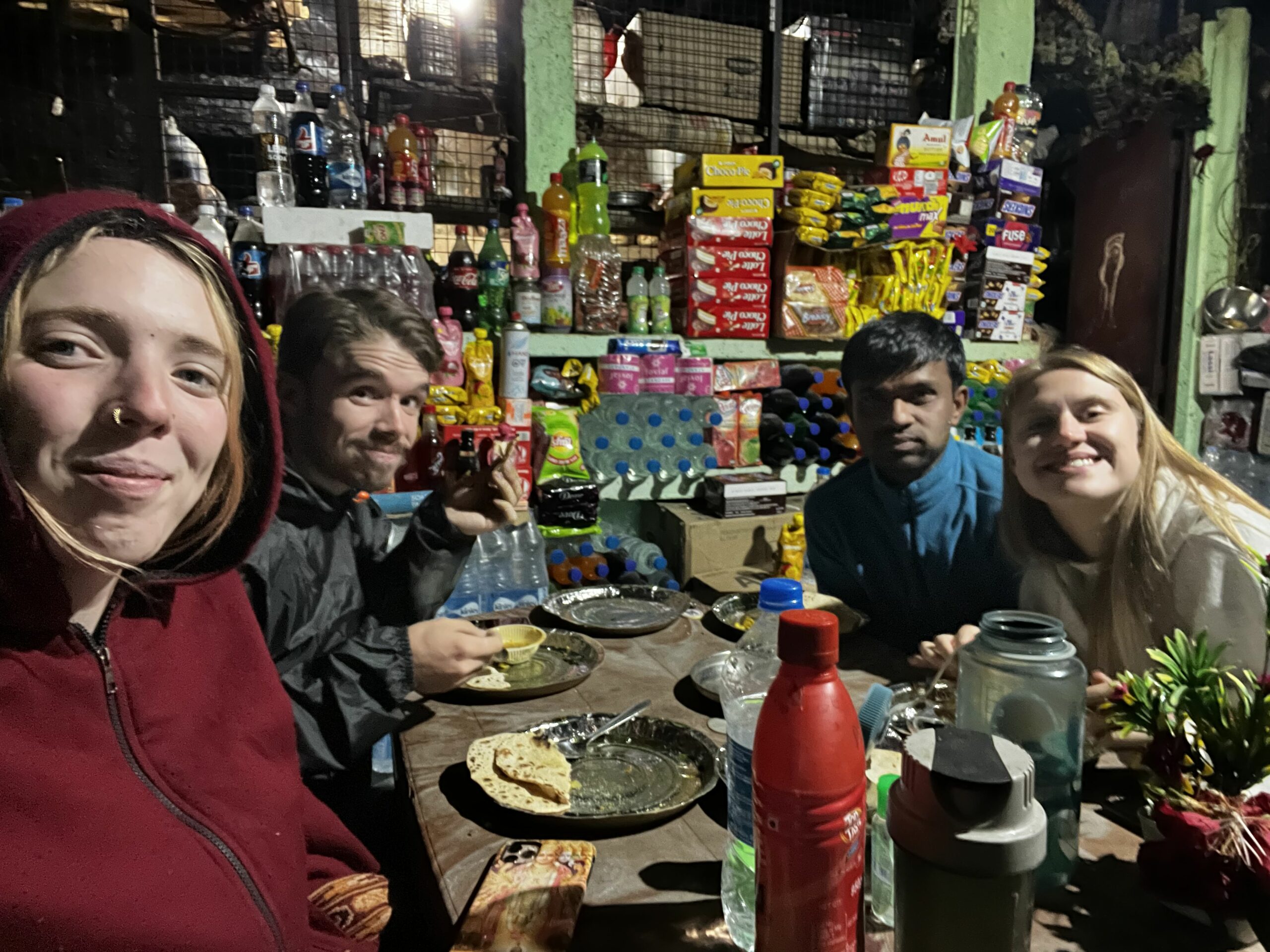
The trek from Sari (2,000m) to Deoriatal (2,300m) is a modest 2.5 kilometers. Despite its short length, it can be a considerable challenge due to its steep ascent, taking about one and a half hours to complete. The well-marked path ensures a secure journey, with beautiful views of Sari Village and the surrounding valley. Along the way, you’d encounter four stalls, any of which are perfect for a rest and a taste of the local Rhododendron juice known as ‘Buransh Ka Sherbat,’ typically priced at INR 50 per glass, if you’re visiting in the right season. These stalls also offer overnight accommodations.
The trail is beautiful. While trekking, you’ll pass through the Sari village and its charming old houses and you’ll get a complete open view of the valley. The trail is surrounded by old trees and it looks like some sort of a fairytale forest. We first thought that it would be possible to go straight from Sari to Chopta, but found out soon enough that this is impossible. The trail, even though it’s such a short distance, took more time than we expected, resulting in us walking in the dark. Don’t get overconfident if you ever find yourself in a similar situation – believe me wen I say that it’s always better to stay over and do the rest tomorrow.
Deoriatal to Chopta Trek
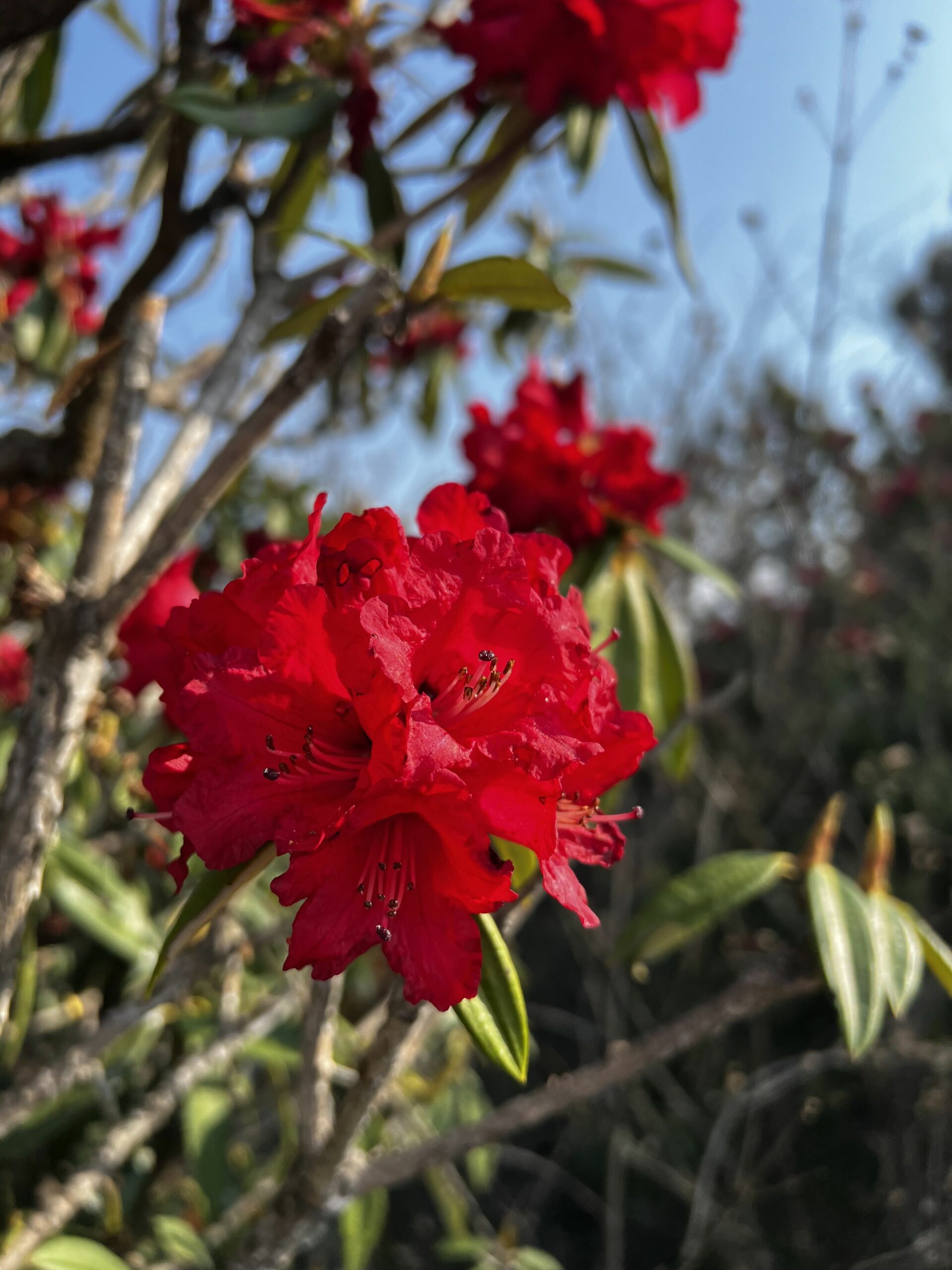
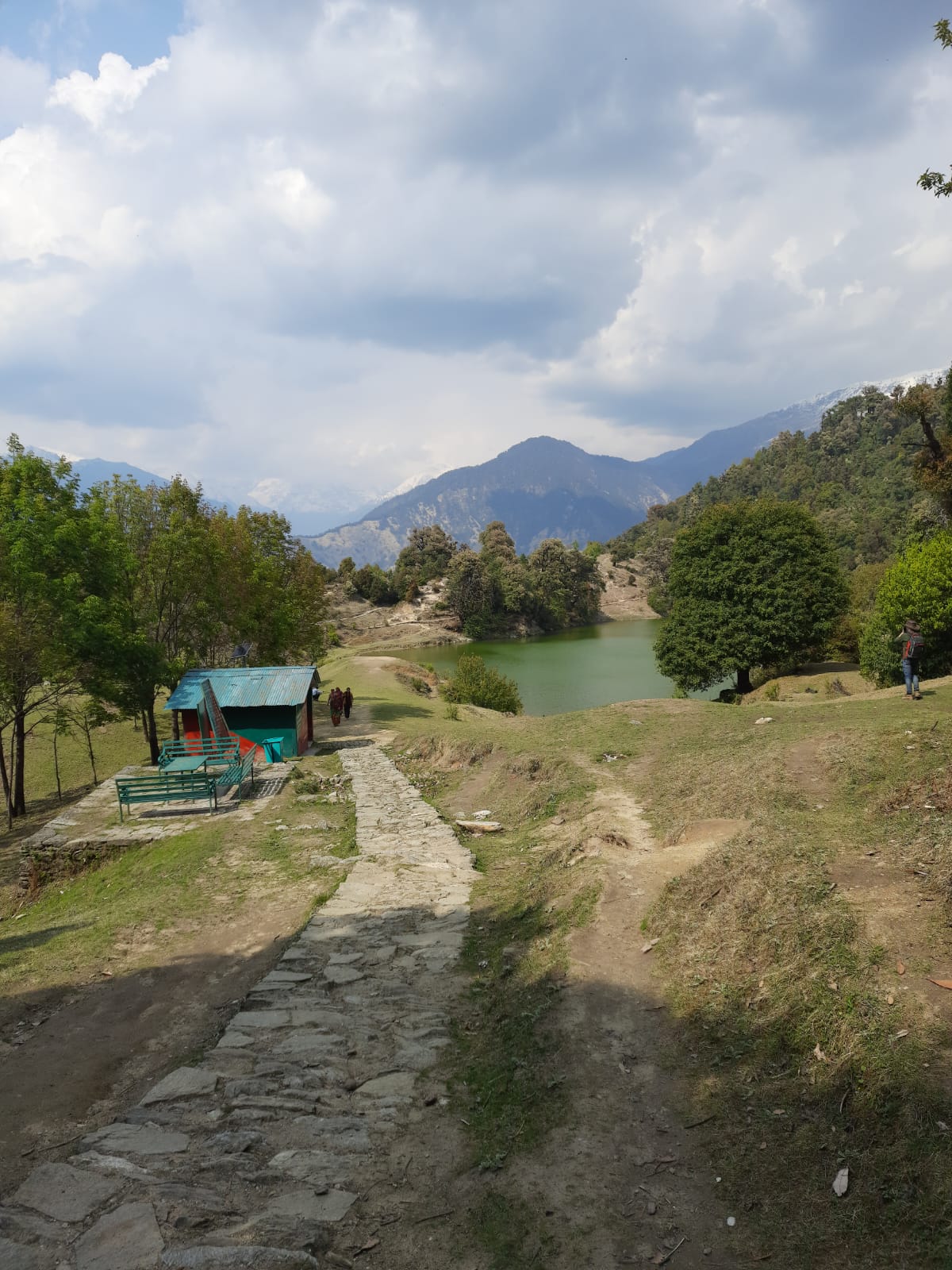
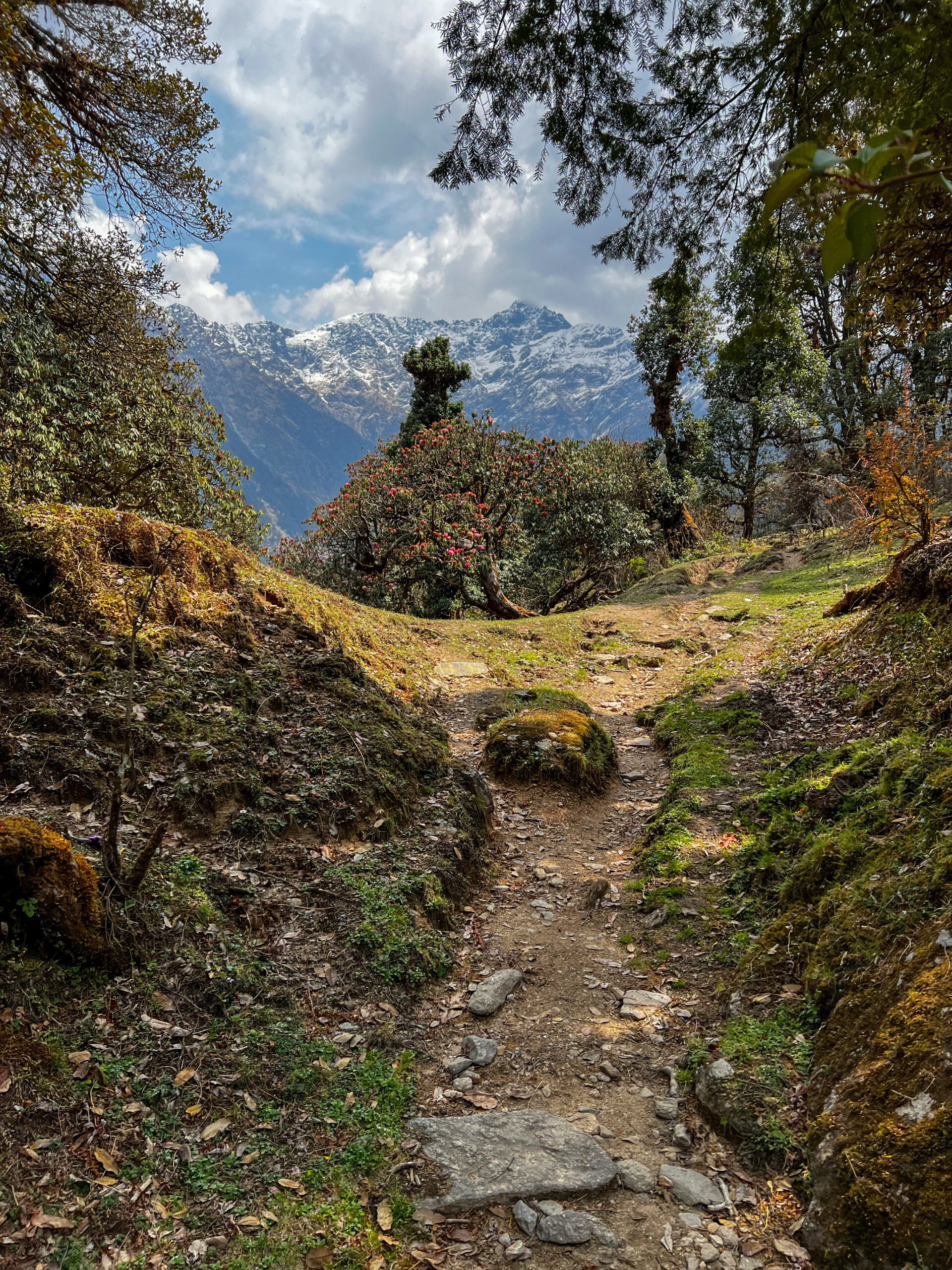
Enter the trek from Deoriatal (2,300m) to Chopta (2,600m), which could be similar to a challenging expedition. While a guide is recommended for this approximately 20-kilometer section lasting around six hours, it’s not mandatory. The trail’s length and its many steep sections contribute to its difficulty level. Preparation is key here – ensure that you have ample snacks, water, and packed lunch for this one, as there are no shops or food stalls along the entire route.
Beginning at the scenic Deoriatal lake, be prepared for a possible INR 200 entry fee for the national park, although we managed to avoid paying this as we left early in the morning and the rangers weren’t present at that time. The lake, surrounded by grass meadows and offering a stunning view of the snow-capped mountain range, sets the stage for the journey ahead.
The real challenge starts after the lake, as you continue your climb further up the mountain. You’d spot many different species of birds here, along with many species of flowers and plants. If you come between March until early May, you’d see thousands of Rhodondendron flowers filling the valley in all different colours. You’ll pass through forests, grass meadows, serene waterfalls, and much more. Another great thing about this trek is how peaceful and quiet it is – we didn’t encounter anyone else while we were on the trail – it’s certainly something you wouldn’t want to miss out on.
How to Reach Chopta By Road?
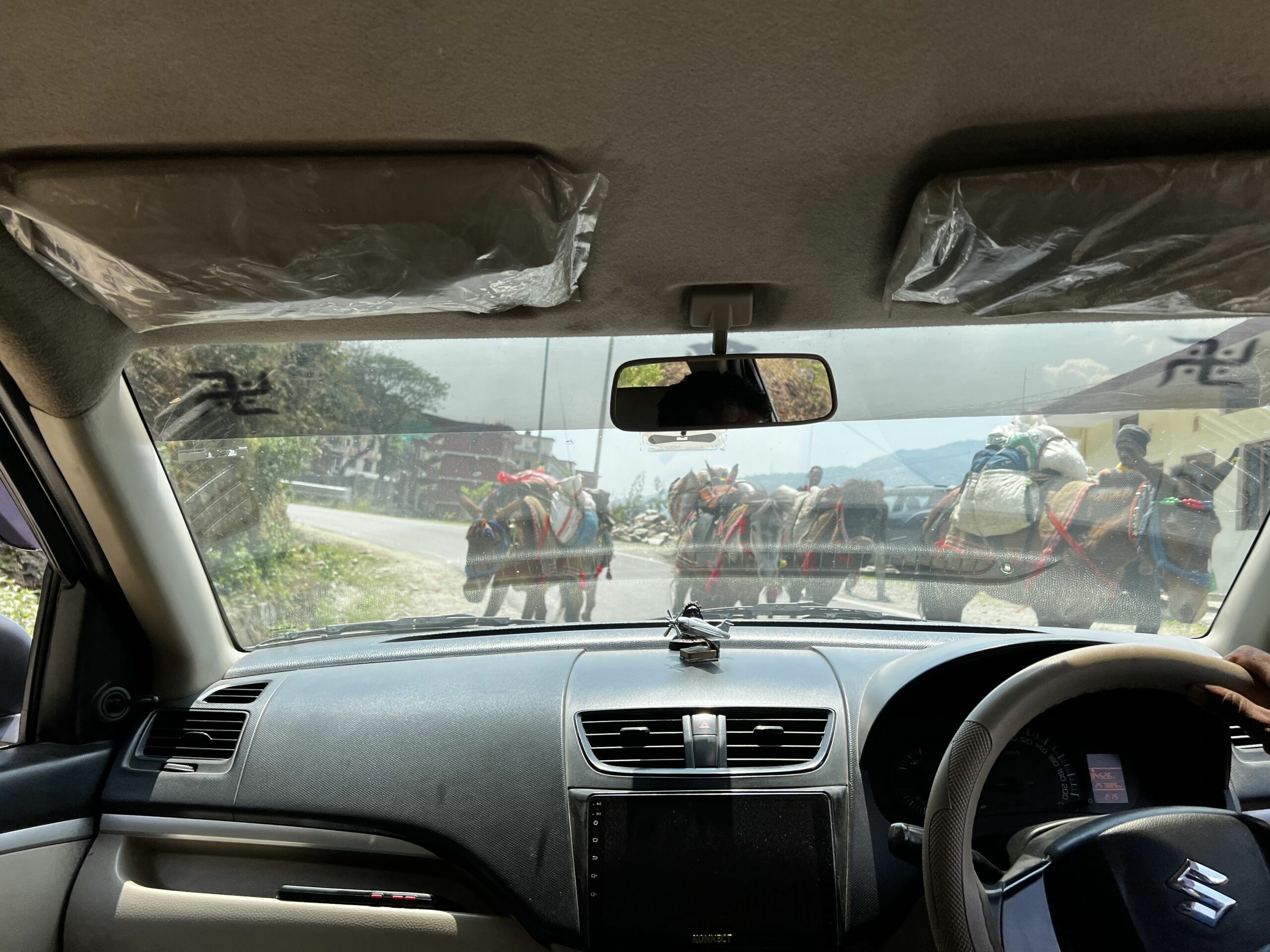
For those opting to bypass the trek from Sari to Chopta, a road connection is available. It can be reached by either public transport or taxi. If you choose to book a taxi, the route from Rishikesh to Chopta covers 200 kilometers in about six to seven hours. A round trip – including the two days of the trek – is about INR 10,000 ($120.13). Other than Rishikesh, Haridwar is another option for a starting point.
For budget-conscious travelers, buses are an alternative, though they are time-consuming and less reliable. Given the absence of direct buses to Chopta, opt for a bus departing from either Rishikesh or Haridwar, heading to Ukhimath. Upon reaching Ukhimath, finalize your journey with a taxi to Chopta.
To find out how much the bus costs, it’s best to check online through Redbus or go to the local bus station. Prices vary and so do the bus schedules.
Where To Stay in Chopta & Food Options
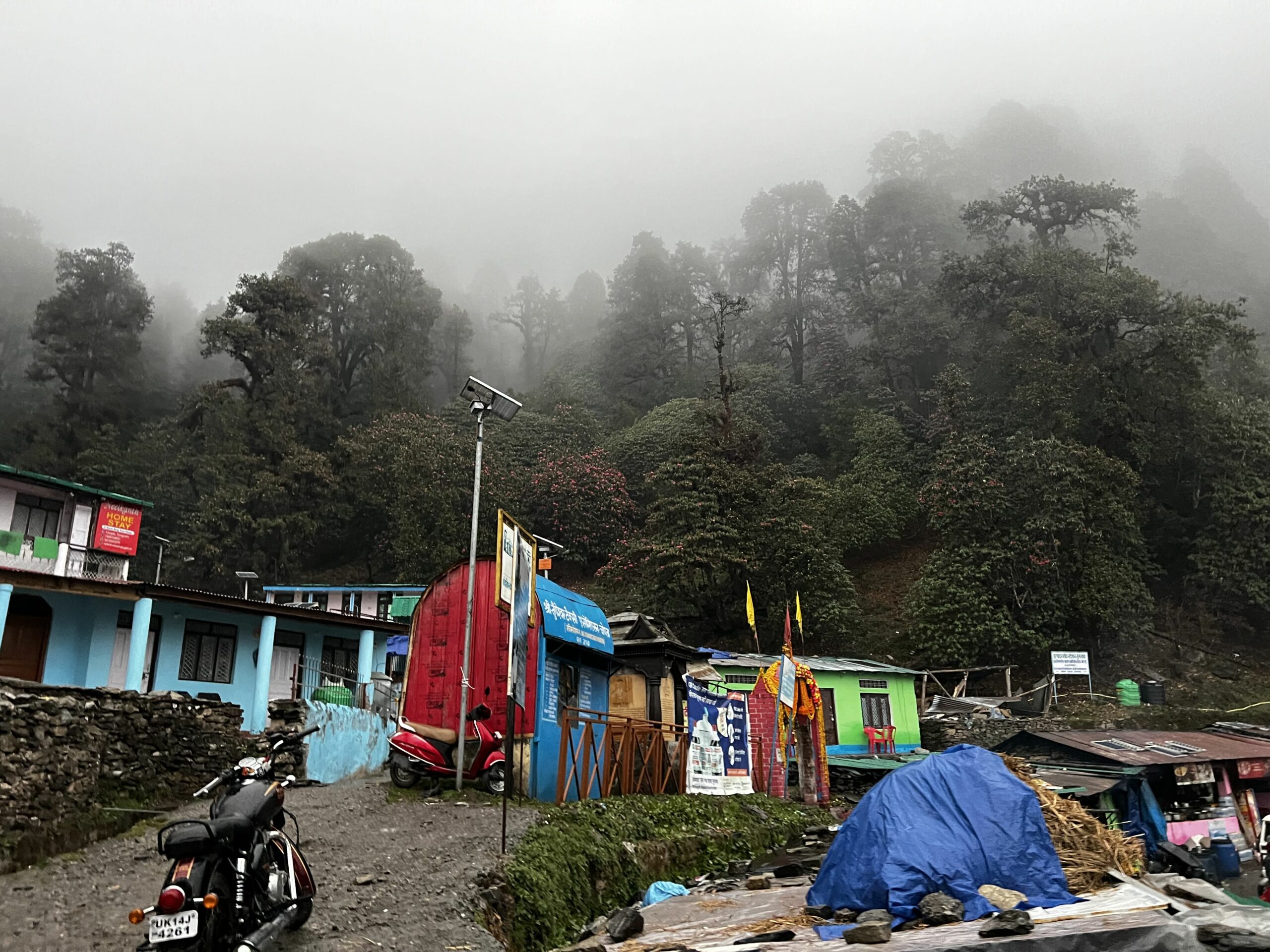
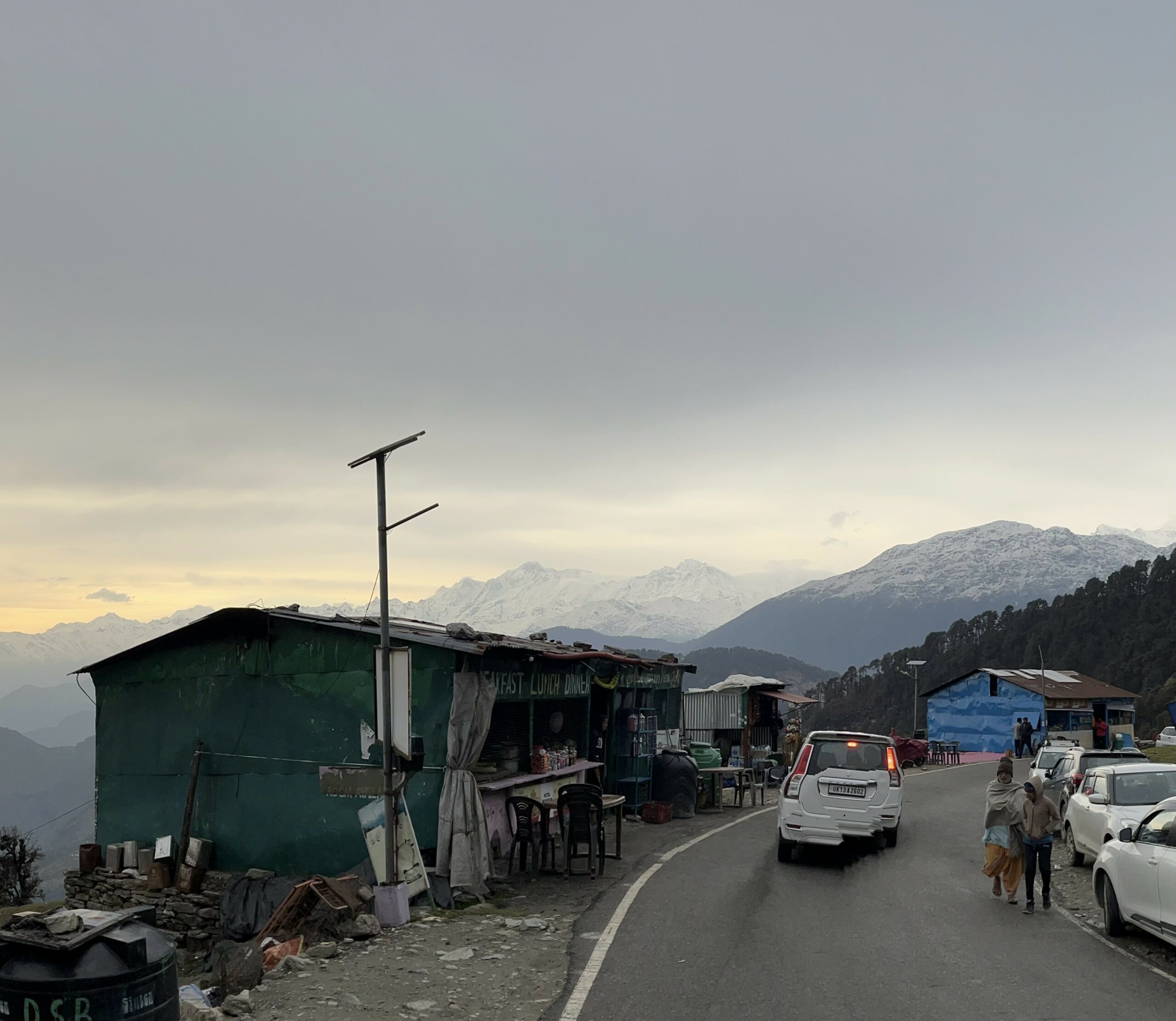
Similar to Sari, finding accommodations in Chopta online can be a challenge. Properties are typically discovered on-site, with a limited number of guesthouses offering basic facilities. Anticipate a no-frills experience without luxuries like hot showers. Our stay, priced at INR 500 each, was negotiable – bargaining is recommended for a better deal. Notably, Chopta operates without electricity and relies primarily on solar panels, so do keep this in mind and bring a power bank along.
There aren’t any fancy restaurants here either. You’d likely end up with Maggi (Indian instant noodles) at one of the many smaller shops. There was one restaurant in Chopta offering a range of curries and dishes, but that was about it.
Chopta to Tungnath
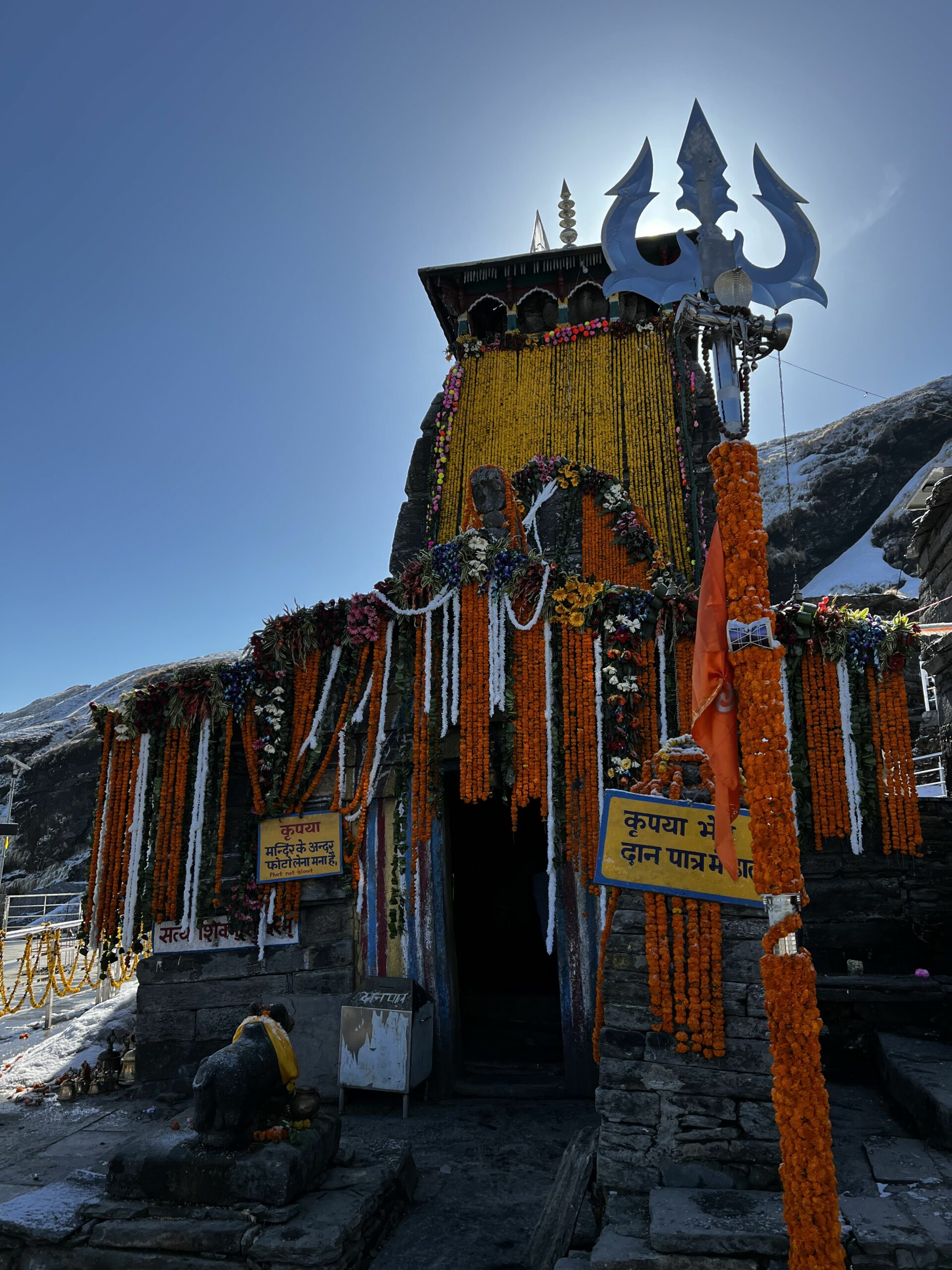
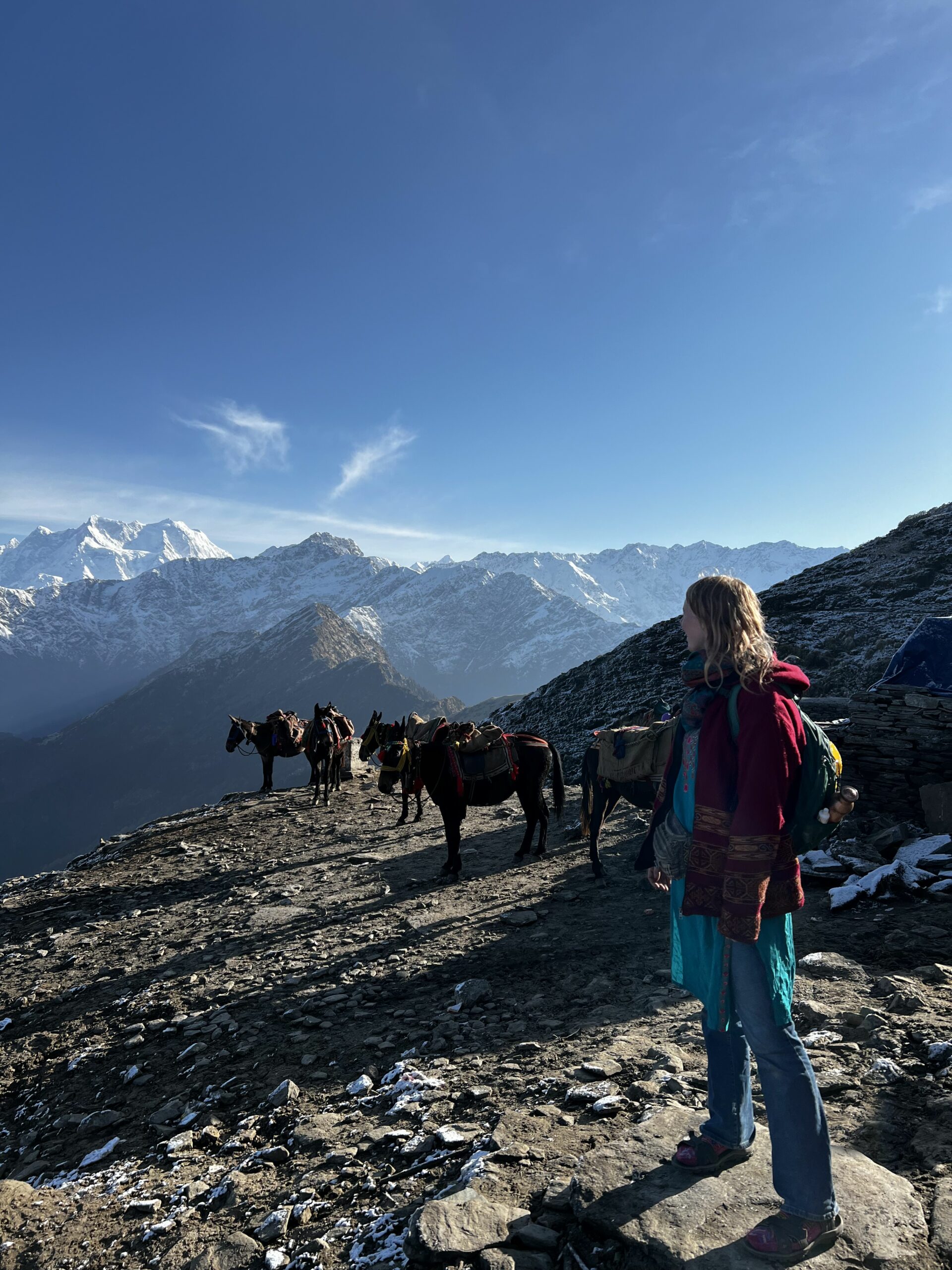
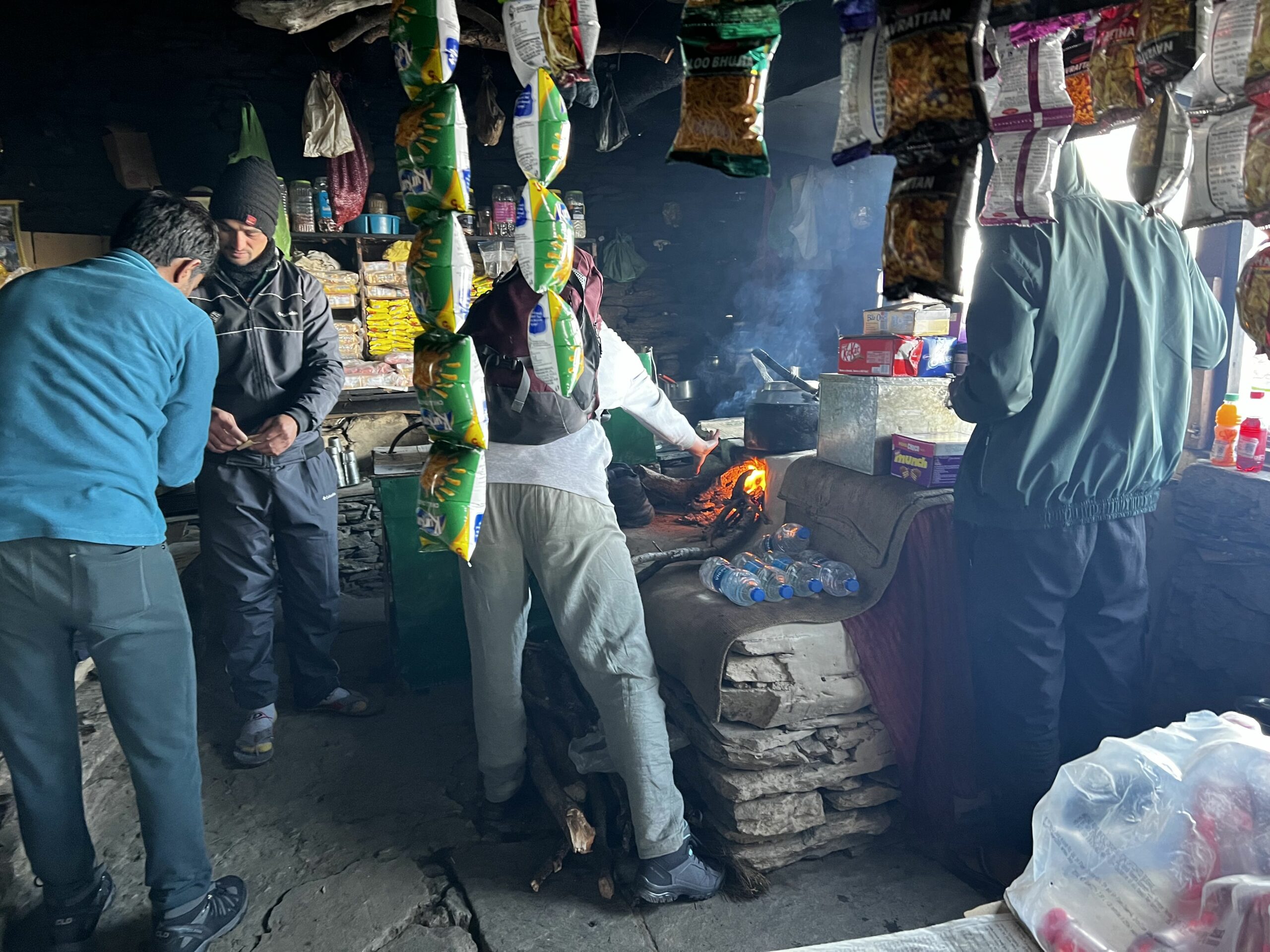
The trek from Chopta (2,600m) to Tungnath (3,690m) is simply breathtaking. You’re completely surrounded by huge Himalayan mountains and get a complete 360 view of the ranges. The trek is approximately five kilometres long and it will take around three hours to reach the Tungnath temple. You’ll gain 1000m in elevation in just five kilometres, so it’s quite steep at certain points. The trail is paved with stones and very easy to follow.
You can’t get lost, and hence don’t really need a guide for this part. On the way up, you can find a few shops and stalls where you can get chai, snacks and breakfast. The rate is significantly higher, though, as the products can only reach here by mules. We paid INR 140 for Maggi on the way, which you can normally get for INR 50. Don’t make the same mistake as me and ask whether they have an omelet, as it’s a holy place and hence completely vegetarian (eggs are considered non-vegetarian in India).
It’s important not to start the trek from Chopta to Tungnath in the dark, as it’s a national park and leopards and other wild animals are a persistent danger. We had read on the internet that it’s advised to leave around 3 AM, which ended in us getting chased by aggressive stray dogs. It was only later that we saw the board of the national park that warned us about hitting the trail at night. Do make sure that you leave early in the morning just before the sun rises, as this trail can get pretty crowded further in the day with people on horses getting carried to the top, and many pilgrims visiting the temple.
Make sure that you take off your shoes before entering the temple premises, just like any other temple in India.
At Tungnath, there are a few guesthouses if you’d like to spend the night here. It’s a great option if you’re planning to go to Chandrashila and want to see the sunrise from there, do note that your route to Chandrashila depends on a few things, like the weather and the current condition of the trail. I’d advise walking a bit ahead on the same day you reached Tungnath and see the condition of the trail – if it looks good or if you’re experienced in hiking on snow and ice, you can stay at Tungnath and see the sunrise from the Chandrashila peak the next morning, if you reach there early enough. If not, you can do it whenever you feel like, though you’d be missing out on the beautiful sunrise..
Fun fact: Tungnath literally translates to ‘Lord of the Peaks’ and is believed to be the highest Shiva temple in the world located at 3,690 meters above sea level.
Tugnath to Chandrashila
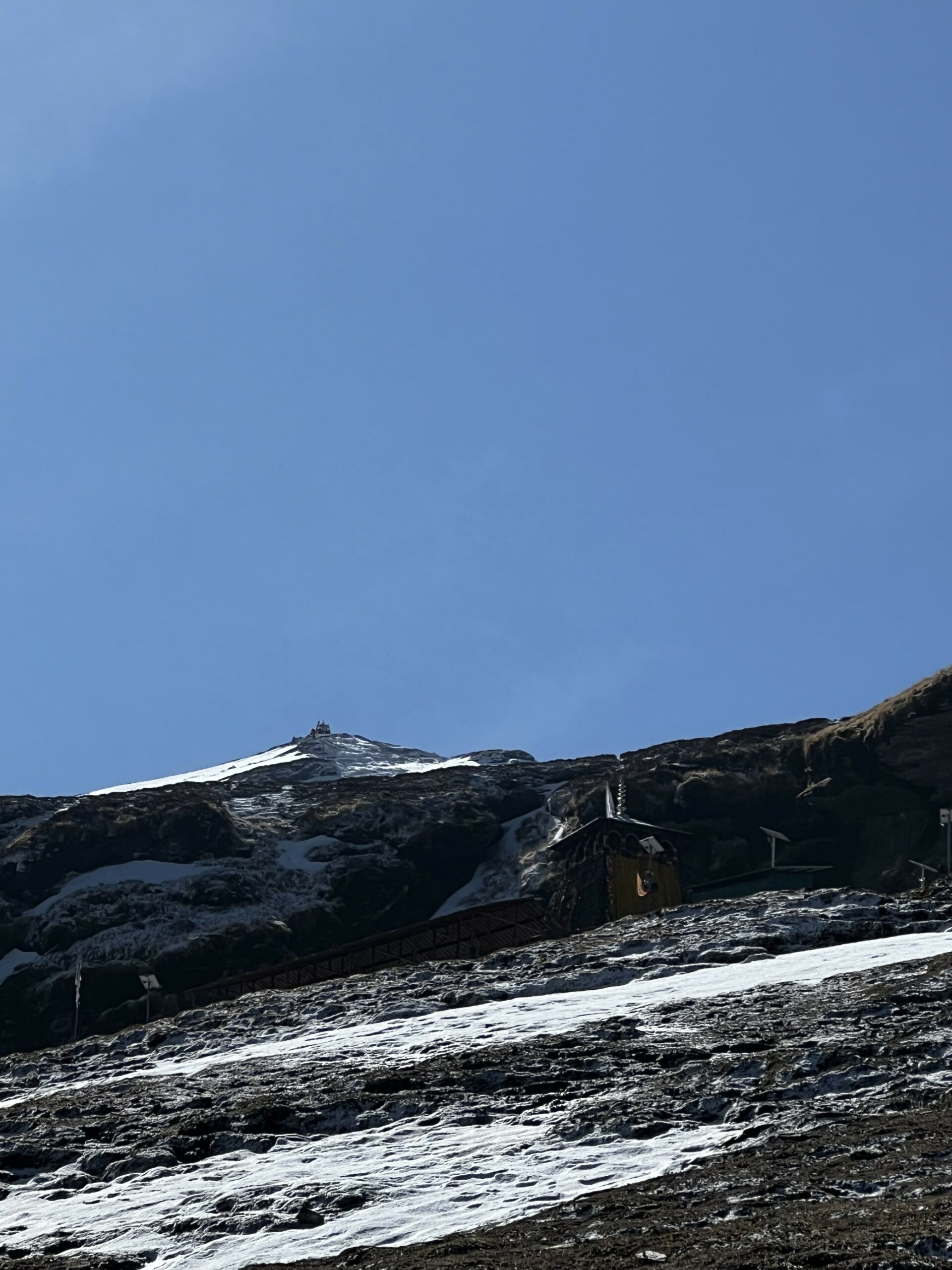
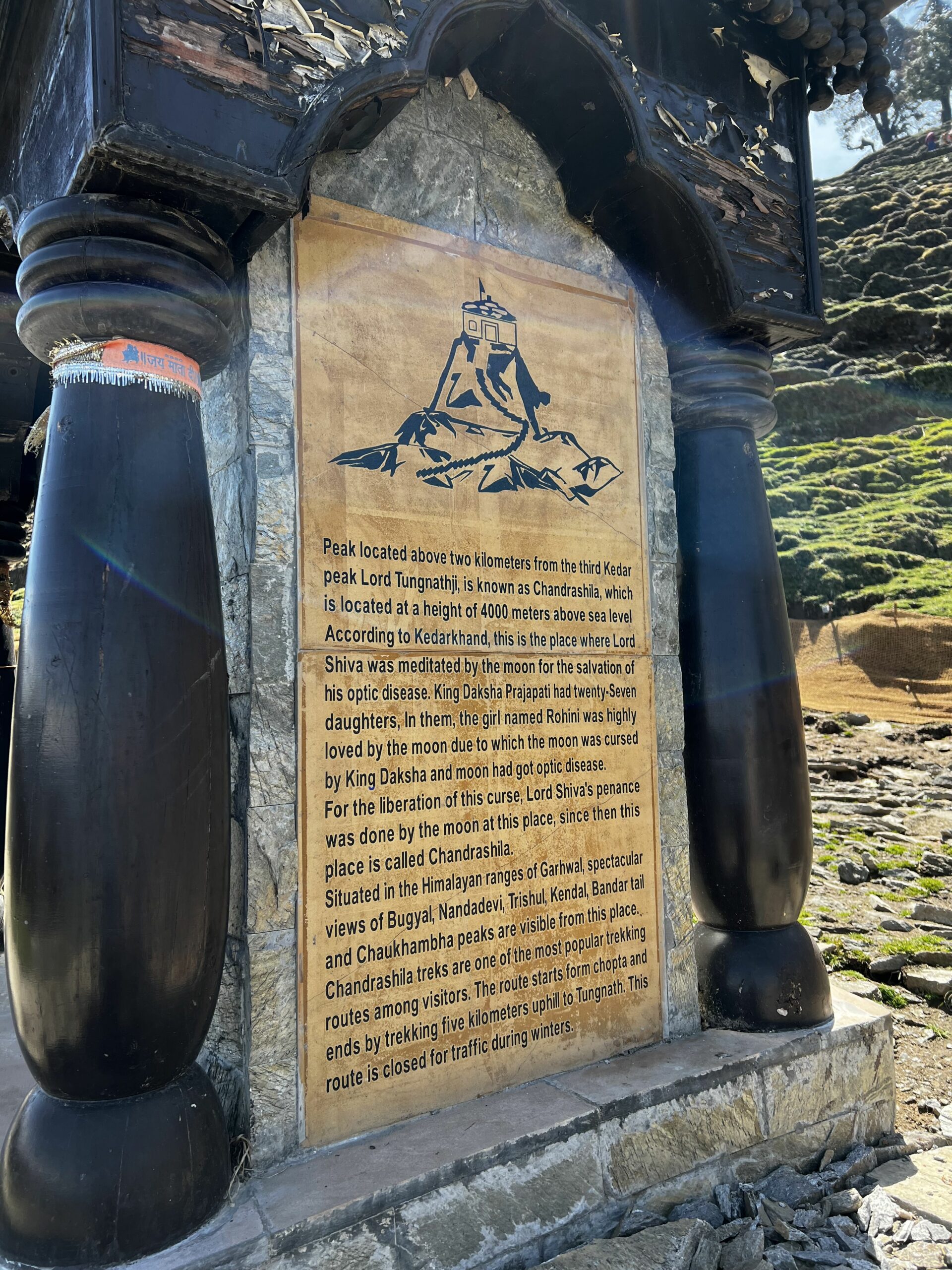
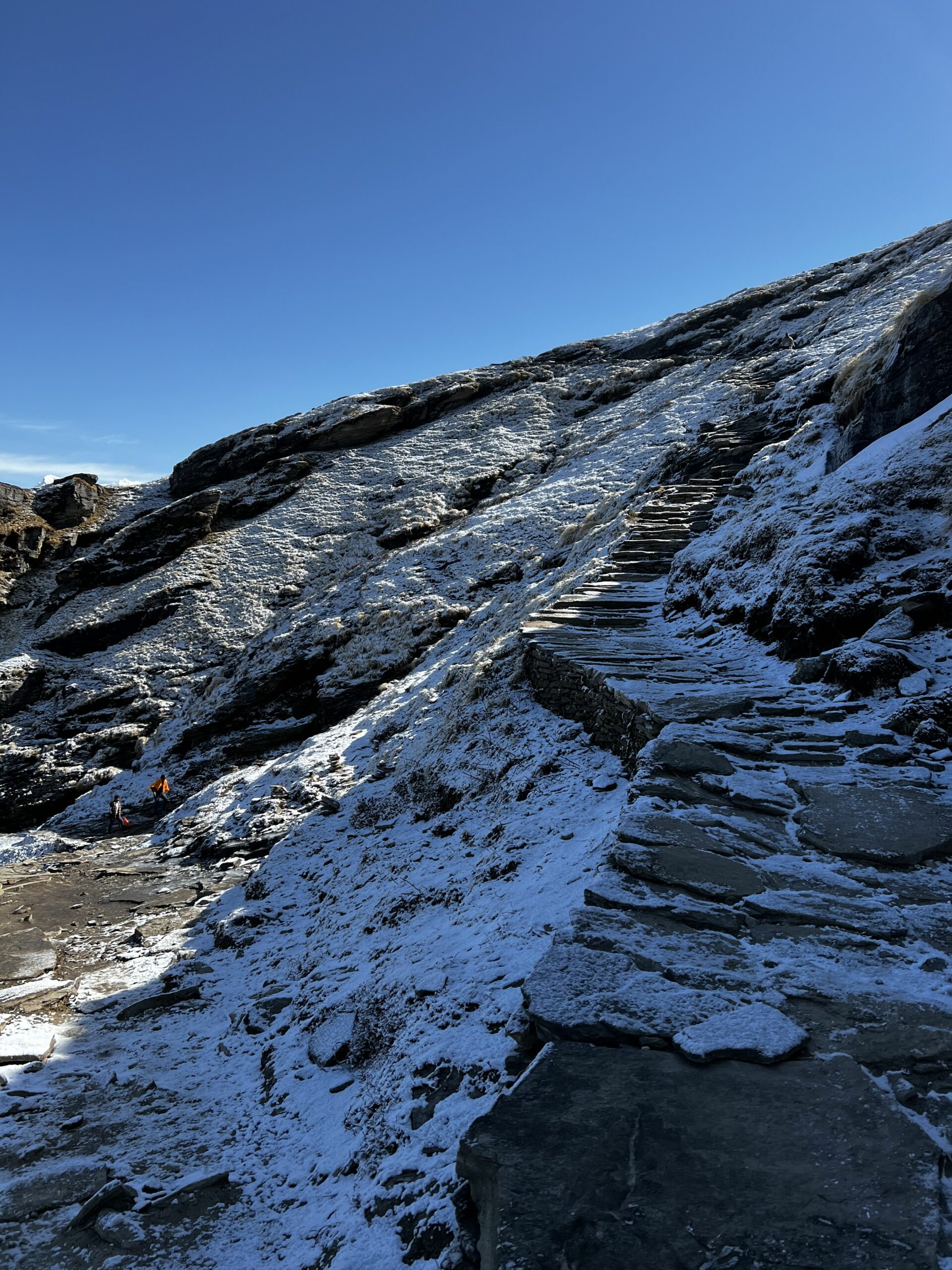
The last part of the trek, Tungnath (3,690m) to Chandrashila (4,000m) is the most difficult part of this whole journey. The distance between the two spots is about 1.5 kilometers and should take around one and a half hour. The path is quite steep with small steps on high altitude, which makes it a bit more challenging.
We couldn’t make it to Chandrashila as the steps were covered in ice and snow, making it incredibly dangerous at that time of the year (April). We tried at first, but when we encountered multiple other trekkers turning back in front of us and warning us about the trail, we turned back. You can only go ahead to Chandrashila if the path is clear or if you have the necessary equipment to walk in snow and ice, like clamp-ons, are experienced with walking in these conditions, or if you’re with an experienced guide.
There are some times in the year – like fall and early winter – when you wouldn’t find any ice on the way. While you can proceed without much worry about the trail, note that temperatures can still get quite unforgiving around those times, so remember to still be careful.
Fun Fact: Chandrashila is believed to be the spot where Lord Rama meditated after defeating the demon king Ravana. The name itself means ‘Moon Rock’ and the peak is said to be bathed in soft moonlight during the night, further adding to its mystical nature.
The Itinerary
Important to note: If you’re going by taxi, ask the driver to stop at Rudraprayag or Srinagar at an ATM, or make sure to do it earlier in Rishikesh or Haridwar. Take a sufficient amount of cash, as it is needed throughout the long journey. There are no ATMs after Sari.
There’s a choice to start your Tungnath trek from Sari. If you go for that option it should take you about three to four days. If you’re not so fond on trekking for long, you can also straight away go to Chopta and start the trek from there, resulting in a two-day trip.
Day 1 Sari to Deoriatal:
- 5:00 – 6:00: Leave from Rishikesh or Haridwar. If you’re using public transport, plan accordingly.
- 13:00 -14:00: Reach Sari village and have lunch.
- 15:00: Start your trek to Deoriatal.
- 17:00 – 18:00: Reach Deoriatal and find accommodation.
- 19:00 – 20:00: Have dinner.
- 21:00 – 22:00: Sleep early, as you’d need to get up early the next day.
Day 2 – Deoriatal to Chopta:
- 5:30: Wake up and get ready.
- 6:00: Have breakfast and get some lunch for on the way.
- 7:00: Leave for the trek.
- 13:00: Have lunch.
- 17:00: Reach Chopta and look for accommodation – you might reach earlier, but try to avoid reaching later as you shouldn’t be on the trail in the dark.
- 19:00: Have dinner.
- 21:00 – 22:00: Sleep.
Day 3 – Chopta to Tugnath:
- 4:00: Wake up and get ready.
- 5:00: Start the trek.
- 9:00: Have breakfast at one of the shops along the trail.
- 10:00 – 11:00: Have lunch at Tungnath temple.
- 12:00: Trek ahead to Chandrashila – if possible.
- 14:00: Reach Chandrashila peak.
- 16:00: Reach Tungnath.
- 17:30: Reach back to Chopta.
I hope that this guide has provided you with valuable insights and practical tips for your upcoming trek to Tungnath and Chandrashila!
Learning from my own experiences, I now understand the importance of proper preparation to ensure a safe and enjoyable journey. I also hope that you don’t face the challenges I did, like unexpected financial hurdles, missing out on the Chandrashila summit, and almost navigating on the trail in the dark in the unseen company of wild animals. I wish you a safe and fulfilling journey to the highest Shiva temple in the world, along with the mystical summit of the Chandrashila Peak.
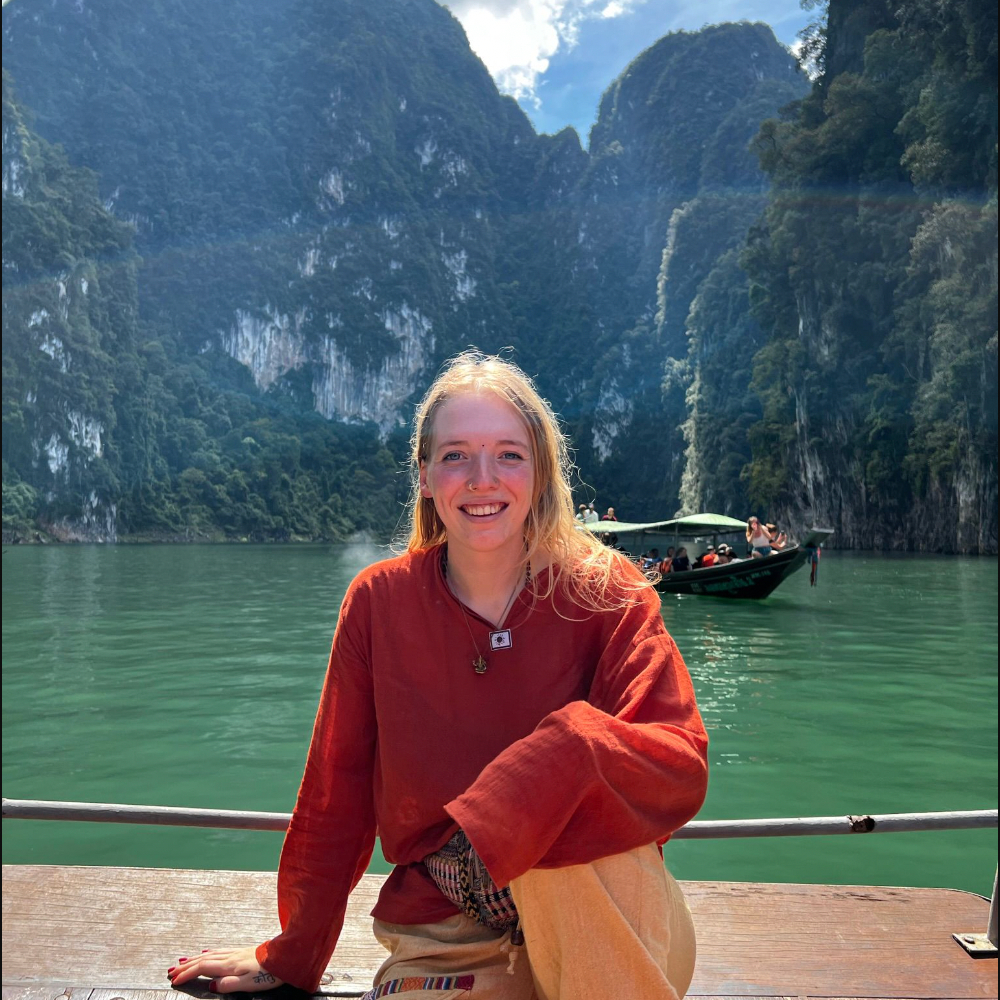
Jytte is a 22-year-old female adventurer from The Netherlands. She loves to fully immerse herself in the local ways of living, going ‘off the beaten path’ to truly experience the countries she visits and their unique way of life. Her wanderlust has taken her to Asia, with a particular focus on India. Here you’ll find her writing about all things India and Asia with a focus on digital nomadding there.
